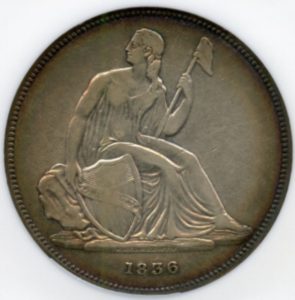Gobrecht Dollar (1836-1839)
Since production of the silver dollar was stopped in 1806, the Gobrecht Dollar was circulated by the United States Mint, minted from 1836 to 1839. It was originally struck in small quantities, to see how the public would receive the reintroduction.
It was due to the efforts of Mint directors Robert M. Patterson and Samuel Moore to revive the coinage, and although they received permission to start back in 1831, it was some years later in 1835 that preparations actually got underway, when Patterson replaced Moore. It was an exciting time for production, seeing keen interest from Government Officials and Mint, not received for a new coin since the 1792 dismes struck.
Desiring to make the coin an artistic wonder, Patterson hired Thomas Sully, an artist, to sketch a figure of Liberty; similar to the figure Britannia on British coins. Not content with stopping there, Titian Peale, a well-regarded painter, was drafted in to design the Eagle for the reverse side of the coin. The Second Engraver, who had been freshly hired, was in charge of transforming these designs across to metal. Upon completion, the Gobrecht was a masterpiece and was a sight to behold, receiving immediate commendation and approval from officials.
The impressive design proudly sported the figure of Liberty, wearing a loose gown and sitting on a rock. Reminiscent of a sculpture from Hellenistic Greece, the figure stared over her shoulder and held the Union shield on her right. On her left-hand side, we saw her holding a tall pole with a Liberty Cap. Aside from this, the design was very plain, there were no stars or anything surrounding her, merely just the date at the bottom. On the reverse, a majestic Eagle takes flight, just as Patterson had wished for to symbolize the optimism that Americans shared for the future of their nation. 26 stars of different sizes surround the eagle to represent the thirteen original states, followed by the thirteen that joined the Union since 1789.
Ready to send their masterful work into the world, November 1863, saw a time where all was ready for silver trial striking. Around 18 new dollars were distributed firstly in Philadelphia. Fortunately, the response was extremely positive. They did encounter a problem, however, when the press criticized Gobrecht as a ‘conceited German,’ due to Latin writing on the coin. At the base of the coin, the words ‘C. GOBRECHT F.’ could be found engraved, with the F referring to FECIT, meaning ‘He made it,’ in Latin. Patterson fixed the problem by removing his name from the base, the 18 originals where you can still see his name are considered extremely rare due to the low number produced.
Around December 1836, production of the Gobrecht Dollar was in full swing. One notable difference from the coins produced later is the flight of the Eagle. Coins dated 1836 will have an upwards flying Eagle, whereas the restrikes produced in the 1850-1860 will see the eagle horizontal.
The Gobrecht dollar proves a popular choice amongst collectors, with the most common coin being the 1836-dated, plain edge with stars on the reverse. Very few collectors have been able to complete a three-peace set, with dollars dated 1836, 1838, and 1839.
